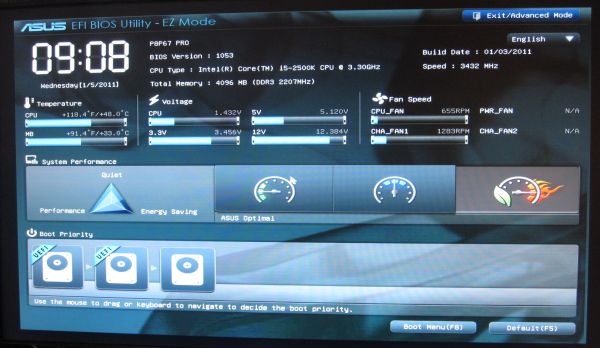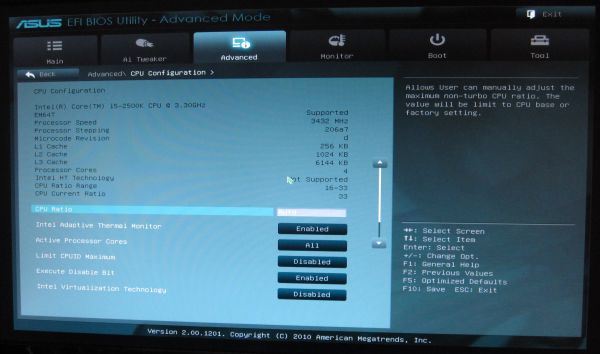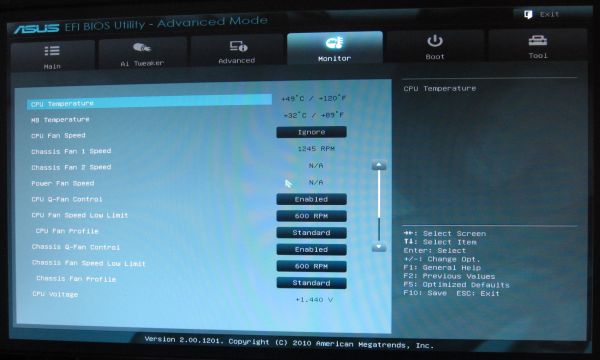The Battle of the P67 Boards - ASUS vs. Gigabyte at $190
by Ian Cutress on January 20, 2011 4:15 PM EST- Posted in
- Motherboards
- Gigabyte
- Asus
- P67
ASUS bring a lot of innovation to the UEFI table over what I have seen from other vendors. The implementation of EZ mode (‘easy’ mode, for us Brits that pronounce that letter ‘zed’) gives the screen below on first entering the UEFI. At a glance, it gives vital motherboard information – CPU, speed, memory, temperatures, voltages, fan speeds, and boot order. The boot order is a great addition, allowing the user to drag-click the order they want. Also available is the three performance options – low power, standard, and performance.
By clicking onto the advanced mode, we get a more BIOS-esque representation of all the motherboard features. The Ai tweaker provides all the overclocking tools we would expect, and more than you find in the Ai Suite in the OS. Features use either a text box for typing values, or a selection box for preset values. The user can utilise the mouse or the keyboard for either task.
Elements such as enhanced sleep states appear under the Advanced CPU Configuration menu, where cores and ratios can be determined. In the Onboard Devices section, if you are not using the Marvell SATA ports, it is advised that this be switched off, to increase boot time by 1-2 seconds.
Fan controls are found in the Monitor tab, where a low limit fan RPM can be given and fan control can be switched between standard/silent/turbo/manual. In manual mode, you can adjust the upper and lower temperature of the fan and at which percentage speed it should run at those temperatures.
Users can specify advanced mode to be shown as soon as the UEFI is selected, and ten UEFI profiles can be saved. The UEFI can also be updated through the Tools tab if the latest file is supplied on a USB drive and plugged in before the ‘update’ option is chosen.
Overclocking
Overclocking on the P8P67 Pro was easy. The UEFI EZ mode offers a performance mode option, which on selecting, enabled the XMP profile of the memory, applied a 103 BCLK, and set the turbo limit to 42x, giving a 4.33 GHz overclock.
As the Ai Suite offers the ‘Auto Tuning’ option, I selected this in the OS and let the program do its thing. After a couple of reboots, and a BSOD, the OS booted into a screen showing a 43x multiplier at 103.5 BCLK (4.45 GHz), and attempted a series of stability tests, slowing increasing the BCLK by 0.5 every 30 seconds. At 105.5 BCLK, a BSOD screen appeared and seemed to crash halfway through, requiring me to reset the system physically. On the next boot, it was stated that the 43x103.5 overclock was applied and now usable. This system is likeable as it promises to adjust depending on how overclockable the processor is.
The downside is that the Ai Suite is quite conservative. I kept with the 103.5 BCLK and went into the UEFI. In advanced mode, adjusting the turbo ratio by one each time and rebooting led to a 46x multiplier (4.76 GHz) successfully passing stability tests. For 47x multiplier (4.86 GHz), I increased the PLL to 1.9V, CPU VCore to 1.42 V, and adjusted the short/long power limits to 150 W/130 W to get a successful stability test pass. This automatically set the memory to a command rate of 3T, so was set back to 1T manually. The 48x multiplier did not boot at this level, and I was not prepared to up the VCore or power limits any more. A 4.86 GHz overclock is very respectable!
At 4.86 GHz (47% OC over 3.3 GHz/non turbo/multithreaded, 31% OC over 3.7 GHz/turbo/single-threaded), the 3D Movement benchmark was run. In single thread mode, a score of 148.92 was achieved, a 31% increase. In multi-threaded mode, a score of 477.60 was achieved, a 37% increase.




















137 Comments
View All Comments
erple2 - Friday, January 21, 2011 - link
Technically, there has simultaneously always and never been a "perfect storm" of price and performance. Things always get faster at the same price point over time.As a commenter above pointed out, while these machines may be able to decode stuff quickly (and I'm guessing the 2600k will be faster), when their "system price" comes down to whatever sweet spot you are targeting, we'll have additional things we want to do with our computers (3D movies, 4K HD, 8K hD etc) that will tax these beyond what we consider "reasonable" today.
Ultimately, things ALWAYS get cheaper for the same level of performance and/or do more with the same cost. That's what progress "mandates". Unfortunately, we demand more things to be done, so the perceived amount of extra work you can do never really seems to go down. I used to be happy running a 386-DX40 in the DOS days. Things seemed fast and speedy then. I acknowledge that I do more today than I did back then, though I'm not sure if that's because the software does more, rather than I do more.
My advice - pick a budget and when you can no longer reasonably do what you now do, then buy with an eye to the future. I picked a fairly high budget, but I wanted to get a 'significant' upgrade that would still be usable 3 years in the future. My Core2Duo lasted from 2007 until the end of 2010, when I (foolishly) bought an i7-950.
marc1000 - Friday, January 21, 2011 - link
and in the 067 boards we can't use the encoding abilities from Sandy Bridge, because the on-chip GPU is turned-off in this chipset. so the only value in $150 boards is x8/x8 PCIe (cheaper boards cut this to x16/x4, a stupid thing but the only way to force us to spend more).medi01 - Saturday, January 22, 2011 - link
Which "encoding abilities" are we talking about, please? Shamelessly hyped increased speed, achieved at the cost of quality loss, eh?Beenthere - Thursday, January 20, 2011 - link
Asus has a long history of delivering half-baked goods - which this review confirms has happened once again. That and the fact that Asus provides zero customer support in my and many other customer's experience, means I'll vote with my wallet and get the Gigabyte mobo. I know the Asus fanbois will ignore the product defects and buy the Asus mobo anyway because of some review which shows it will OC by 2 Hz. more or something insignificant. This is how Asus dupes the naive kids.Rick83 - Thursday, January 20, 2011 - link
Well, I'm monitoring the Gigabyte boards, and there's the same image as you'd expect from the ASUS side. Plus with the weird BIOS-flash thing happening on all the boards, and the features that are missing on the Gigabyte boards, I think I'll take an ASUS this time around. (Though any board will be a step down from my brilliant IP35 Pro.... RIP ABIT)Digital Audio Inputs seem to have died out completely....
In the end, I think I'll go with the microATX ASUS in the new Fortress FT3 by Silverstone...
SmCaudata - Thursday, January 20, 2011 - link
I want to do the same build. I'm hoping for a new GENE or equivalent ASrock board. The FT3 looks like it can handle SLI well. Would be fun to build that powerful of a system in w small package and still have awesome thermals.Gothmoth - Thursday, January 20, 2011 - link
gigabyte boards make way more trouble then asus boards.don´t remind me on the samsung drives or hitachi drives that would not work for 8 month with gigabyte boards.
take a look at gigabytes support forum and you will see how "happy" the gigabyte users are. LOL.
milkyway4me - Thursday, January 20, 2011 - link
Asus does advance RMA, gigabyte doesn't. That and that alone, is why any reasonable person should choose Asus barring some massive issue that sticks out to them.Duwelon - Thursday, January 20, 2011 - link
And i've had the exact experience with Asus and Gigabyte. Last 3 computers I built all used Gigabyte board. 1 bad video card (fanless gigabyte 4550 and they replaced it with a geforce 9600gt with a fan... gee thanks for the downgrade in performance and features and upgrade in noise, thanks so very much). 1 Gigabyte board is acting up, the NIC keeps disappearing without a trace, had to install a PCI NIC to keep it on the network. I friggin hate Gigabyte's RMA process, but they're still better than some i've had to use. Asus, never had a problem with their RMA and they were a little faster than Gigabyte from what I remember. To each their own, sadly they both have flaws and neither are much better than the other. Overall though, given my recent screwing over by Gigabyte and recent issues, my pendulem is swinging towards Asus again.seamusmc - Friday, January 21, 2011 - link
I've had boards from all major vendors, ASUS, Intel, Gigabyte, Abit, DFI, etc. They've all had duds and they've all had great boards. I currently have 4 ASUS x48 Rampage's, (Home Server, Work, Wife and Game), and it is one of my favorites among many favorites. ASUS CULV is another stand out in my memory.In my experience, ASUS hasn't delivered more half-baked goods then anyone else.
Right now, it seems to me all the boards are having issues and that's to be expected with a new chipset. This is why I decided last month, despite my unquenchable hunger to upgrade, to wait at least until Feb to upgrade. At this point I may wait until March.